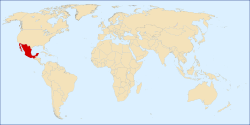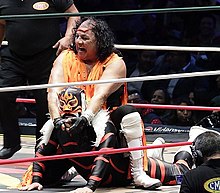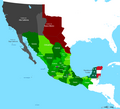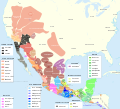Portal:Mexico
|
The Temple of Warriors at Chichen Itza, Mexico
¡Bienvenido! Welcome to the Mexico portal
Mexico, officially the United Mexican States, is a country in the southern portion of North America. It covers 1,972,550 km2 (761,610 sq mi), making it the world's 13th-largest country by area; with a population of almost 130 million, it is the 10th-most-populous country and the most populous Spanish-speaking country. Mexico is organized as a federal constitutional republic comprising 31 states and Mexico City, its capital. It shares land borders with the United States to the north, with Guatemala and Belize to the southeast; as well as maritime borders with the Pacific Ocean to the west, the Caribbean Sea to the southeast, and the Gulf of Mexico to the east.
This is a Featured article, which represents some of the best content on English Wikipedia.
Romance is the eighth studio album by Mexican singer Luis Miguel. It was released by WEA Latina on 19 November 1991. Although the production was originally intended as another collaboration with Juan Carlos Calderón, that plan was scrapped when Calderón was unable to compose songs for the album. Facing a new-material deadline in his recording contract, at his manager's suggestion Miguel chose bolero music for his next project. Mexican singer-songwriter Armando Manzanero was hired by WEA Latina to co-produce the album with Miguel. Recording began in August 1991 at Ocean Way Recording in Hollywood, California, with Bebu Silvetti the arranger. On the album Miguel covers twelve boleros, originally recorded from 1944 to 1986. The first two singles, "Inolvidable" and "No Sé Tú", reached number one on the Billboard Hot Latin Songs chart in the United States and spent six months atop the Mexican charts. "Mucho Corazón" and "Cómo" were in the top five of the Hot Latin Songs chart, and "Usted" and "La Barca" received airplay throughout Latin America. Miguel promoted the record with a tour of the United States and Latin America. The album was generally well received by music critics, who praised Miguel's singing and the record's production. The singer received several accolades, including a Grammy nomination for Best Latin Pop Album. (Full article...)Selected article -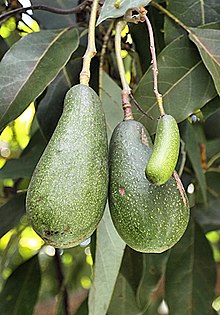 Avocado production is important to the economy of Mexico with the country being the world's largest producer of the crop. Mexico supplies 45 percent of the international avocado market. Of the 57 avocado producing countries, the other major producers are Colombia, Peru, Dominican Republic, and Kenya, in that order. The 'Avocado Belt of the Mexican Republic' includes Michoacán and the State of Mexico. The major cultivars in Mexico are Fuerte, Hass, Bacon, Reed, Criollor, and Zutano. (Full article...)Selected picture Alejandra Lagunes, Coordinator of the National Digital Strategy of the Presidency of Mexico. image credit: Alejandra Lagunes
This is a Good article, an article that meets a core set of high editorial standards.
Jerry Estrada (full name, Gerardo Hernández Estrada; born January 10, 1958, Monclova, Coahuila) is a semi-retired Mexican luchador (professional wrestler). For most of his career, he has portrayed a rudo (heel, those that portray the "bad guys") character, nicknamed "El Puma". His rudo persona was pattered on various Glam Rock bands, complete with colorful spandex and what was described as a "rock and roll" attitude in the ring. He was originally active from 1978 until 2003 when he was forced to retire due to chronic injures caused by his signature bumps outside the ring. Estrada began working select matches again in 2018. Estrada was a major star for Empresa Mexicana de Lucha Libre (EMLL) during the 1980s but was one of the first wrestlers to leave EMLL to work for Antonio Peña's newly started Asistencia Asesoría y Administración (AAA) in 1992. He also had a brief run in the World Wrestling Federation (WWF) in 1997 and 1998 when AAA and WWF had a working agreement. From 1991 to 2008 Mini-Estrella Enrique del Rio worked under the ring name Jerrito Estrada, a mini version of Jerry Estrada. (Full article...)Selected biography -Francisco Ignacio Madero González (Spanish pronunciation: [fɾanˈsisko jɣˈnasjo maˈðeɾo ɣonˈsales]; 30 October 1873 – 22 February 1913) was a Mexican businessman, revolutionary, writer and statesman, who served as the 37th president of Mexico from 1911 until he was deposed in a coup d'état in February 1913 and assassinated. He came to prominence as an advocate for democracy and as an opponent of President and de facto dictator Porfirio Díaz. After Díaz claimed to have won the fraudulent election of 1910 despite promising a return to democracy, Madero started the Mexican Revolution to oust Díaz. The Mexican revolution would continue until 1920, well after Madero and Díaz's deaths, with hundreds of thousands dead. A member of one of Mexico's wealthiest families, Madero studied business at the École des Hautes Études Commerciales de Paris. An advocate for social justice and democracy, his 1908 book The Presidential Succession in 1910 called Mexican voters to prevent the reelection of Porfirio Díaz, whose regime had become increasingly authoritarian. Bankrolling the opposition Anti-Reelectionist Party, Madero's candidacy garnered widespread support in the country. He challenged Díaz in the 1910 election, which resulted in his arrest. After Díaz declared himself winner for an eighth term in a rigged election, Madero escaped from jail, fled to the United States, and called for the overthrow of his regime in the Plan of San Luis Potosí, sparking the Mexican Revolution. (Full article...)
In the news
Selected fare or cuisine - A calavera (Spanish – pronounced [kalaˈβeɾa] for "skull"), in the context of Day of the Dead, is a representation of a human skull or skeleton. The term is often applied to edible or decorative skulls made (usually with molds) from either sugar (called Alfeñiques) or clay, used in the Mexican celebration of the Day of the Dead (Spanish: Día de Muertos) and the Roman Catholic holiday All Souls' Day. Calavera can also refer to any artistic representations of skulls or skeletons, such as those in the prints of José Guadalupe Posada, or to gifts or treats in relation to the Day of the Dead. Some widely known calaveras are created with cane sugar, decorated with items such as colored foil, icing, beads, and sometimes objects such as feathers. They range in multiple colors. Traditional methods for producing sugar skulls with molds have been in use for a long time, though the first known mention of the sale of skeletal figures dates to the 1740s. The sugar skulls were originally created as gifts, to be eaten by children. They are sometimes now used as offerings to be placed on altars known as ofrendas ("offerings") for Día de Muertos. It has been argued that the tradition has roots in indigenous celebrations, by groups including the Aztec, Mayan, and Toltec commemorations. However, what we now call Day of the Dead is more Catholic than indigenous because the Spanish tried to eradicate indigenous religions Moreover, as Stanley Brandes has argued, these skulls and skeletons have seven characteristics. They are: (1) ephemeral; (2) seasonal; (3) humorous; (4) secular; (5) commercial; (6) made for living people; (7) meant to be played with; (8) small and transportable; (9) made and consumed by an urban population. They are "lighthearted emblems of death." Thus they are not derived from sacred Mesoamerican traditions. (Full article...)
General imagesThe following are images from various Mexico-related articles on Wikipedia.
CategoriesTopicsRelated portalsWikiProjectYou are invited to participate in WikiProject Mexico, a WikiProject dedicated to developing and improving articles about Mexico. Associated WikimediaMore portals | ||||||||||




